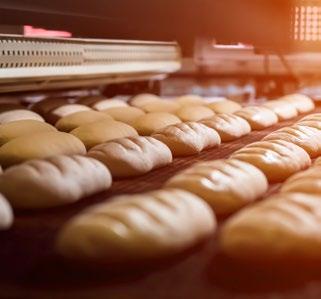
3 minute read
DELTA ELECTRONICS
Controlling the Bake of the Perfect Loaf
Bread. Just thinking of the word pushes your olfactory senses to imagine yeastbased delights at the counter of your favorite bakery. But baking the perfect loaf, and in large enough quantities, demands furnaces that accurately control the process from beginning to end. This was precisely the task faced by Mechatronics Ltd., a system integrator and official distributor of Delta Motion, Drive, Control, and Robotics products based in Bulgaria.
The requirements for the bread furnace machine defined four temperature zones. The first zone is especially powerful to compensate for the cooled conveyor belt and the relatively cool loaf entering the oven. At this step, steam is also injected into the furnace to give it that freshlybaked sheen. It is followed by three temperature-controllable baking zones that are carefully controlled for baking the optimal loaf. The conveyor belt of this traveling oven design must also be held at the correct speed throughout the process. Rounding off the specifications was a human-machine interface (HMI) to configure the baking process, deliver temperature status of each zone, and output any error status information.
For the HMI, the team selected the Advanced HMI DOP-107WV from the DOP-100 Series. This touch-based control panel features a 16:9 7» color TFT screen with a modern-looking, narrow frame. Its multilingual support meant it was well-suited for the target market, while user-friendly editing software ensured that the final user interface was easy to navigate. With several RS-485 capable COM ports, it integrated perfectly with the other components selected for the furnace. Considering the operating environment, the flat, wipeable surface of the DOP-107WV proved the ideal choice for a dusty bakery. Control for the conveyor was implemented using an MS300 Series inverter. This AC motor variable frequency drive (VFD) also supported the RS-485 Modbus interface and is ideal for open-loop control of IM and PM motors.
Of course, the quality of the bake is ultimately defined by the furnace. Special attention was given to selecting the optimal control approach for the seven heating elements used. After careful deliberation, the DTC1000 Temperature Controller was selected as the main controller, with DTC2000 controllers used in parallel for the remaining six heaters. These are also connected to the Modbus. The selection of established, reliable components, along with the careful programming, were critical in delivering a low-maintenance design that could be operated 24/7.
To provide optimal temperature regulation, the auto-tuning function of the DTC1000/2000 was used. The inputs are acquired from third-party PT100 temperature sensors while control of the heating elements is implemented with solid-state relays. Auto-tuning uses a training process to configure the closedloop PID controller once the sensors and heaters are installed in this 250 kW furnace. Further complicating the implementation is the dual heating and sensing of the last three baking zones. With one heater above the conveyor and the other below, each needs to be set to a different temperature. Spare outputs from the Delta Temperature Controllers were available and linked to relays for audible and visible alarm signals. These signals were also replicated in the DOP107WV HMI.
Closely coupled with the quality of the bake is the speed control of the conveyor belt. The MS300 VFD is linked to an inductive proximity sensor that is easy to clean and remains accurate in the dusty baking environment. Installed closed to the gears, the built-in programmable logic controller (PLC) of the MS300 is configured to monitor and calculate the conveyor speed. This is continuously compared it to the setpoint defined in the HMI. Thus, the end-customer only needs to set the desired baking time, the required temperature, and then press run to start baking.
The Mechatronics Ltd. team benefited from the broad range of industrial automation solutions in the Delta portfolio. Integration of the VFD, HMI, and Temperature Controller was simplified thanks to the out-of-the-box interoperability and connectivity of the components selected.
Most people would assume that baking bread is very simple. On the contrary, the bread furnace project has highlighted the skill required of both bakers and engineers to create a machine that delivers the perfect loaf. The auto-tuning function of the DTC1000/2000 played a large part in ensuring that bakers can deliver a quality product every batch, by providing excellent temperature control,» said Victor Ogedegbe, Field Application Engineer at Delta.










